When we think about the art of controlled chaos on four wheels, Japanese drift cars immediately come to mind. These precision-engineered machines have transformed what started as mountain pass racing into a global phenomenon that’s captured the hearts of automotive enthusiasts worldwide.
We’ve witnessed Japan’s drift culture evolve from underground touge battles to mainstream motorsport, with iconic vehicles like the Nissan Silvia, Toyota AE86, and Mazda RX-7 leading the charge. These legendary machines didn’t just define a driving style – they created an entire subculture that values skill, style, and the perfect balance between power and control.
Today, we’ll explore the intriguing area of Japanese drift cars, from their humble beginnings on mountain roads to their current status as automotive icons. Whether you’re a seasoned drift enthusiast or just discovering this thrilling motorsport, understanding these remarkable machines will give you insight into one of Japan’s most influential automotive exports.
The Legendary Nissan 240SX (S13/S14/S15)
The Nissan 240SX stands as the ultimate drift car platform that defined an entire generation of enthusiasts. We’ve witnessed countless drivers master their skills behind the wheel of these affordable rear-wheel-drive legends.
Why the 240SX Became a Drift Icon
Affordability made the 240SX accessible to grassroots drifters when other sports cars remained financially out of reach. Entry-level S13 models sold for under $3,000 in the early 2000s, allowing young enthusiasts to purchase their first drift car without very costly.
Perfect weight distribution creates the ideal foundation for controlled oversteer with the 240SX’s near 50:50 balance. Engineers designed these chassis with excellent front-to-rear weight proportions that naturally encourage predictable sliding characteristics.
Rear-wheel-drive layout provides the essential mechanical setup that makes drifting possible without complex drivetrain modifications. Power flows directly to the rear wheels, eliminating the understeer tendencies found in front-wheel-drive platforms.
Abundant aftermarket support developed around the 240SX platform as companies recognized the massive enthusiast demand. Manufacturers like Megan Racing, Godspeed, and ISIS Performance created comprehensive product lines specifically for these chassis.
Lightweight construction keeps curb weights between 2,700-2,900 pounds across all generations, making power modifications more effective. Aluminum hoods, fiberglass body panels, and stripped interiors can reduce weight even further for competitive applications.
Engine Swap Options for Maximum Power
SR20DET swaps remain the most popular engine conversion among 240SX owners seeking turbocharged performance. These 2.0-liter engines produce 205-250 horsepower in stock form and easily support 400+ horsepower with proper modifications.
LS engine swaps deliver massive torque and reliability that transforms the 240SX into a tire-shredding monster. LS1, LS2, and LS3 variants provide 350-430 horsepower from the factory while offering excellent tuning potential and parts availability.
2JZ-GTE conversions create some of the most powerful 240SX builds when budget allows for this premium swap option. Toyota’s legendary inline-six easily produces 500-1000+ horsepower with supporting modifications and proper tuning.
| Engine Option | Stock HP | Tuning Potential | Swap Cost Range |
|---|---|---|---|
| SR20DET | 205-250 | 400-500 HP | $3,000-5,000 |
| LS1/LS2/LS3 | 350-430 | 500-700 HP | $5,000-8,000 |
| 2JZ-GTE | 320 | 500-1000+ HP | $8,000-15,000 |
RB25DET and RB26DETT swaps offer the authentic Nissan performance experience with distinctive turbo sound and response characteristics. These Skyline-derived engines provide excellent power delivery curves perfectly suited for drift applications.
Suspension and Handling Modifications
Coilover suspension systems replace the factory struts and springs to provide adjustable ride height and damping control. Quality setups from companies like BC Racing, Fortune Auto, and Stance offer 32-way damping adjustment for precise handling tuning.
Angle kits increase steering lock beyond the factory 33-degree limitation to achieve greater drift angles. Aftermarket kits from Wisefab, SLR, and DNA Motoring can provide 45-65 degrees of lock for competition-level transitions.
Limited slip differentials ensure both rear wheels receive power during drift maneuvers instead of spinning one wheel uselessly. Clutch-type LSDs from Kaaz, OS Giken, and Cusco offer adjustable preload settings for different driving styles.
Roll cage installation strengthens chassis rigidity while providing crucial safety protection during high-speed drift sessions. Chromoly steel cages from companies like AGI and Autopower meet competition safety requirements while improving structural integrity.
Aggressive wheel and tire setups optimize traction balance between front grip and rear slip characteristics. Most drift 240SX builds run 225-255 width tires up front with 265-295 rear tires to achieve the perfect push-pull ever-changing.
The Iconic Toyota AE86 Corolla
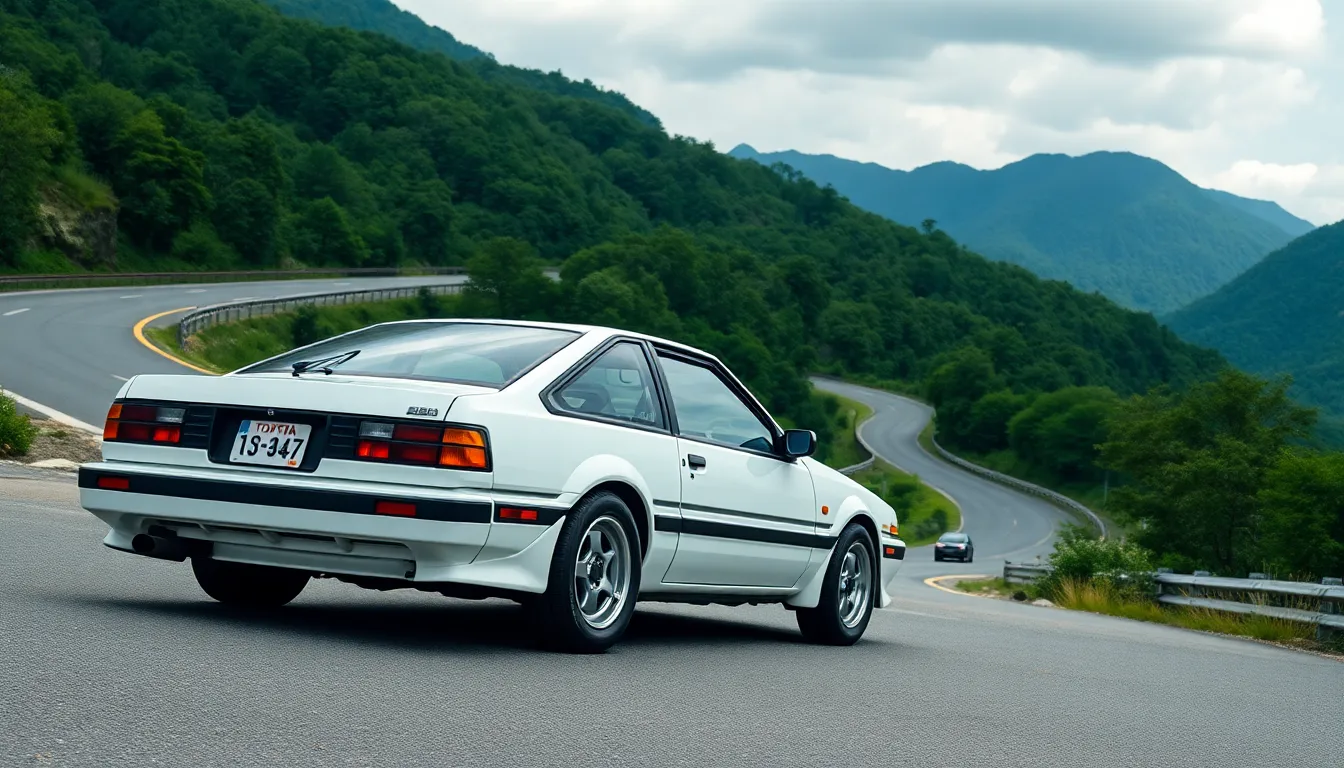
While the 240SX earned its reputation through raw potential, the Toyota AE86 Corolla achieved legendary status through perfect engineering balance. We consider this compact coupe the spiritual foundation of modern drifting culture.
The Hachi-Roku’s Perfect Weight Distribution
Balance defines everything about the AE86’s drift capability. Toyota engineers achieved a near-perfect 53:47 front-to-rear weight distribution that creates predictable oversteer characteristics. The lightweight 2,400-pound chassis responds instantly to throttle inputs and steering corrections.
Front engine placement sits behind the front axle centerline. This configuration reduces polar moment inertia and allows drivers to control weight transfer with precision. We’ve found that skilled drivers can maintain controlled slides through technical corners that would challenge heavier platforms.
Rear wheel drive layout complements the balanced chassis design. Power delivery flows directly to the rear wheels through a simple differential system. The combination of lightweight construction and optimal weight placement makes the AE86 incredibly responsive to driver inputs.
Drift Scene Origins with the AE86
Mountain pass racing in Japan established the AE86’s drift reputation during the 1980s. Enthusiasts discovered that the Corolla’s balanced handling made it ideal for the tight, winding roads of Mount Akina and other touge locations. These early adopters developed techniques that would later define professional drifting.
Initial D manga and anime series immortalized the AE86 in popular culture. The fictional character Takumi Fujiwara’s white and black Corolla introduced millions of fans worldwide to the concept of drift racing. We’ve witnessed how this media exposure transformed a practical economy car into a global icon.
Professional drift competitions adopted the AE86 as a benchmark platform. Early Formula Drift events featured many AE86 builds competing against more powerful vehicles. Drivers like Rhys Millen and Alex Pfeiffer proved that skill and setup could overcome horsepower disadvantages.
Modern Value and Collectibility
Market prices for clean AE86 examples have increased dramatically over the past decade. We’ve tracked values rising from $8,000 for decent examples in 2010 to over $25,000 for pristine models today. Rare variants like the SR5 and GTS command even higher premiums.
Restoration costs often exceed purchase prices for project vehicles. Original body panels, interior components, and mechanical parts have become increasingly scarce. We recommend budgeting $15,000 to $30,000 for a complete restoration beyond the initial purchase price.
Investment potential continues growing as supply decreases globally. Many AE86 models have been modified, crashed, or scrapped over their 35-year lifespan. Clean, unmodified examples represent some of the most appreciating assets in the Japanese car market.
The Powerful Nissan Skyline GT-R Series
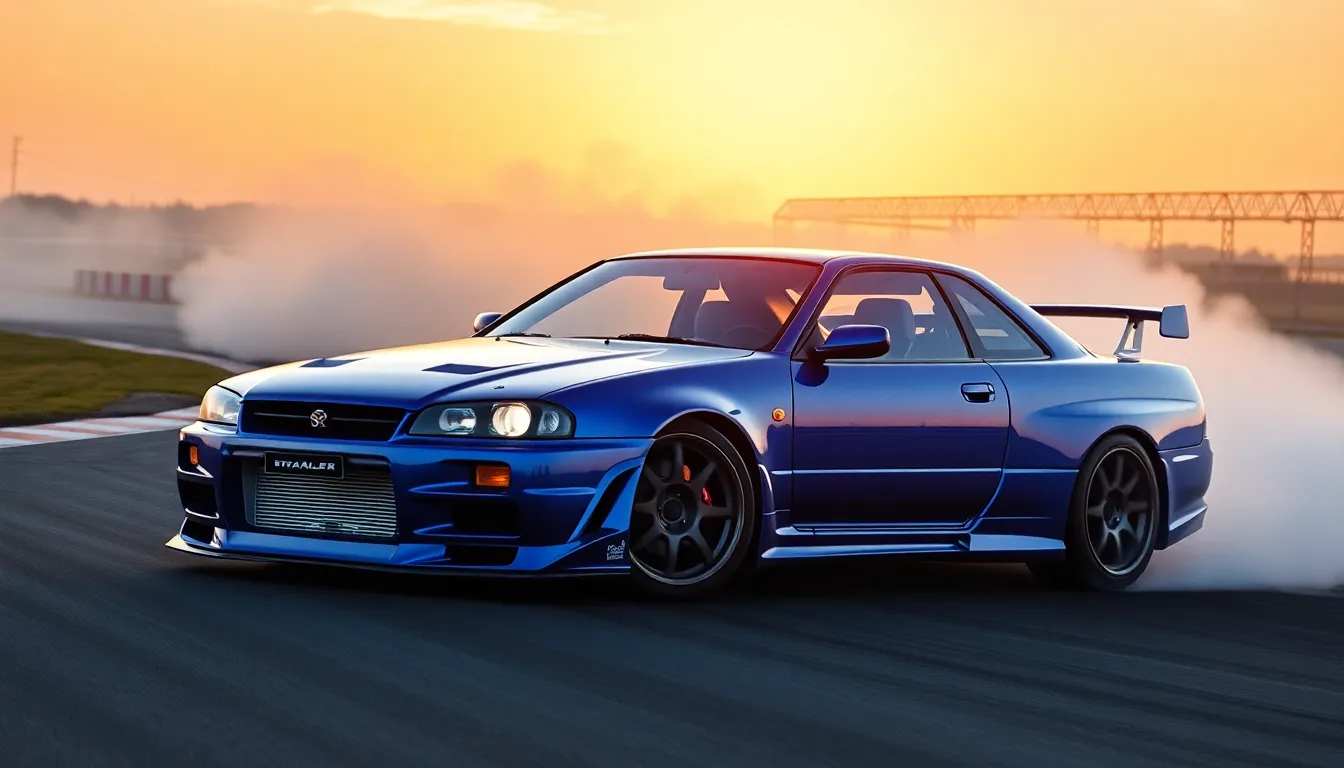
While the 240SX and AE86 dominate grassroots drifting, the Nissan Skyline GT-R series represents the pinnacle of Japanese performance engineering in drift competitions. These legendary machines combine raw power with precision handling that’s redefined what’s possible on the drift track.
R32, R33, and R34 Drift Capabilities
R32 GT-R drift cars deliver exceptional performance through their iconic RB26DETT twin-turbo inline-six engine producing 276 horsepower from the factory. We’ve witnessed countless R32 builds pushing 500+ horsepower with relatively simple modifications like larger turbochargers and engine management upgrades.
R33 GT-R models offer improved aerodynamics and a longer wheelbase that enhances stability during high-speed drift entries. Professional drifters often prefer the R33’s refined suspension geometry, which provides more predictable handling characteristics compared to its predecessor.
R34 GT-R platforms represent the ultimate evolution of the Skyline drift legacy with advanced ATTESA E-TS all-wheel drive systems and sophisticated electronics. These cars feature the most refined RB26DETT engines with improved turbocharger response and stronger internal components that handle aggressive tuning better than earlier generations.
All-Wheel Drive Conversion to Rear-Wheel Drive
Converting GT-R all-wheel drive systems to rear-wheel drive requires removing the front driveshaft, transfer case components, and ATTESA E-TS controller to reduce weight by approximately 200 pounds. We’ve seen this modification become standard practice among serious drift competitors who prioritize rear-wheel dynamics over traction advantages.
Professional conversion kits eliminate complex electronics while maintaining the GT-R’s robust rear differential and drivetrain components. These conversions typically cost between $2,000-$4,000 depending on whether teams retain the original transmission or upgrade to a sequential gearbox.
Weight distribution improvements result from removing front drivetrain components, shifting the balance closer to the ideal 50:50 ratio that drift cars demand. Many teams report improved throttle response and more predictable oversteer characteristics after completing RWD conversions.
Professional Drift Team Preferences
Formula Drift teams increasingly choose R34 GT-R chassis for their structural rigidity and tunability potential, with engines regularly producing 800-1,200 horsepower for competition use. Teams like Falken Tire Drift and HGK Racing have demonstrated the platform’s capabilities in professional competition.
Engine swap popularity includes LS variants and 2JZ-GTE powerplants when teams want alternatives to the RB26DETT, though many purists maintain the original Nissan engines for authenticity. We’ve documented successful builds using both approaches in top-tier drift competitions.
Chassis modifications focus on aggressive suspension geometry with custom fabricated control arms, roll cages exceeding FIA safety specifications, and hydraulic handbrake systems for precise rear brake control. Professional teams typically invest $50,000-$100,000 in complete GT-R drift builds before reaching competitive readiness.
The Affordable Mazda RX-7 (FC and FD)
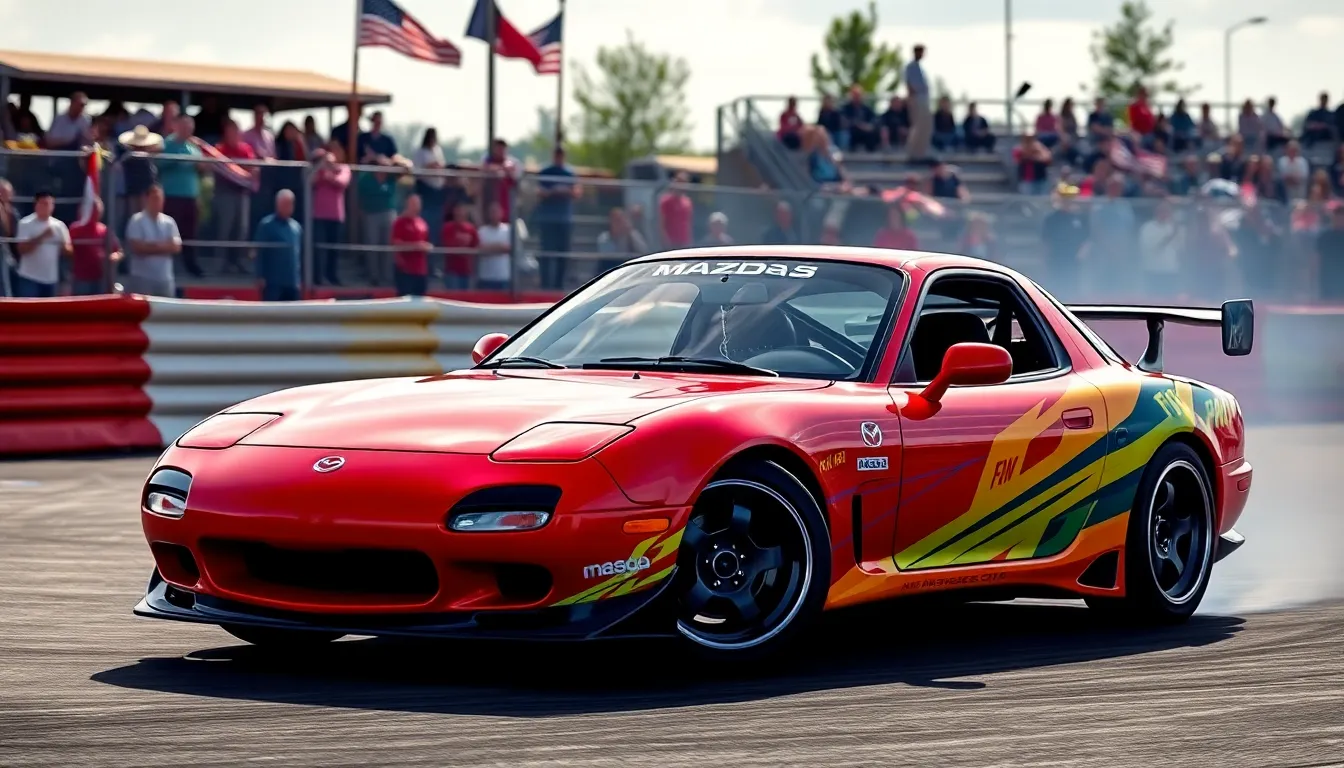
We’ve witnessed the Mazda RX-7’s rise from affordable sports car to drift legend across two generations. The FC (1986-1991) and FD (1992-2002) platforms offer unique rotary advantages that complement the drift scene perfectly.
Rotary Engine Advantages for Drifting
Compact powerplant design creates an ideal weight distribution for drift cars, with the 13B rotary engine weighing approximately 250 pounds compared to typical inline engines at 400+ pounds. Smooth power delivery eliminates the torque spikes that can upset chassis balance during transitions, allowing drivers to maintain control through extended drift angles.
High rpm capability extends well beyond 8,000 rpm in modified applications, providing consistent power throughout the drift zone. Linear throttle response gives drivers precise control over rear wheel slip, making it easier to modulate drift angles compared to turbocharged alternatives.
Low center of gravity positioning places the engine further back and lower than conventional layouts, improving the car’s natural tendency to rotate. Reduced vibration through the drivetrain helps maintain tire contact during aggressive driving, contributing to better predictability in drift scenarios.
Lightweight Chassis Benefits
Overall curb weight ranges from 2,800 pounds in FC models to 3,100 pounds in FD variants, making them significantly lighter than contemporary drift platforms like the 240SX or Skyline. Front to rear weight distribution achieves nearly perfect 50:50 balance in stock form, eliminating the need for extensive weight relocation modifications.
Compact dimensions measure 168 inches in length for the FC and 169 inches for the FD, providing excellent maneuverability on tight drift courses. Short wheelbase of 95.3 inches in both generations enhances rotation speed and makes the car more responsive to steering inputs.
Rigid chassis construction utilizes a unibody design with strategic reinforcement points that resist flex during high stress cornering. Lower moment of inertia compared to larger platforms means the RX-7 changes direction more quickly, requiring less effort to initiate and maintain drifts.
Common Mechanical Challenges
Apex seal wear represents the most important maintenance concern, with seals typically requiring replacement every 60,000 to 80,000 miles depending on driving conditions and maintenance quality. Cooling system complexity in FD models includes multiple radiators and intercoolers that require careful attention to prevent overheating during extended drift sessions.
Oil consumption rates average 1 quart per 1,000 miles in healthy rotary engines, necessitating frequent monitoring and quality oil changes every 2,500 miles. Fuel system modifications become necessary for increased power levels, as stock injectors and fuel pumps reach their limits around 300 horsepower.
Turbo replacement costs can exceed $2,000 for sequential turbo systems in FD models, while single turbo conversions offer more affordable alternatives starting around $3,500. Electrical gremlins affect aging models, particularly in areas like the fuel pump relay and ECU connections that can cause intermittent running issues during competitions.
The Versatile Toyota Supra (A70 and A80)
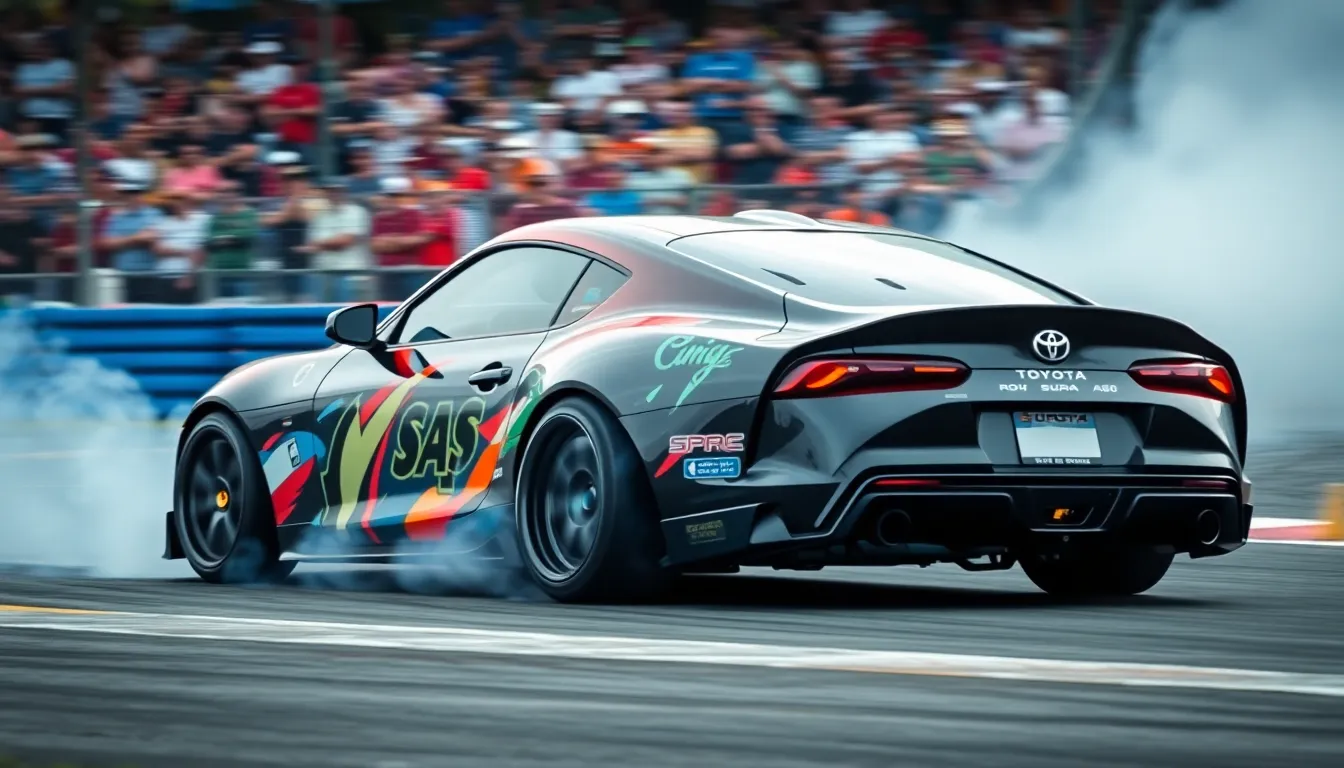
Two generations of the Toyota Supra have earned legendary status in Japanese drift culture. Both the A70 (1986-1993) and A80 (1993-2002) models continue to dominate drift scenes worldwide due to their robust construction and modification potential.
2JZ Engine Potential for Drift Builds
Power delivery from the 2JZ-GTE turbocharged inline-six makes the Supra an exceptional drift platform. Factory output reaches 276 horsepower, but the engine’s cast-iron block construction handles extreme modifications with remarkable reliability. Professional drift teams regularly push 2JZ engines beyond 800 horsepower using upgraded turbos, fuel systems, and engine management.
Torque characteristics of the 2JZ provide smooth power bands ideal for maintaining controlled drifts. Naturally aspirated 2JZ-GE variants offer linear throttle response that helps beginners learn drift techniques without sudden power spikes. Turbo models deliver adjustable boost levels through wastegate modifications, allowing drivers to fine-tune power delivery for different track conditions.
Aftermarket support for 2JZ engines exceeds most other Japanese powerplants. Companies like HKS, Greddy, and Precision Turbo manufacture complete turbo kits, forged internals, and standalone ECU systems specifically designed for drift applications.
Weight Distribution Considerations
Balance points on both Supra generations require careful attention for optimal drift performance. Factory weight distribution sits at approximately 53:47 front to rear, creating slight front-heavy characteristics that affect initiation techniques. Professional drift builds often relocate batteries, fuel cells, and other components toward the rear to achieve neutral balance.
Center of gravity positioning benefits from the 2JZ engine’s low mounting position and longitudinal orientation. Weight sits closer to the ground compared to V8 swaps, improving stability during transitions and maintaining predictable handling characteristics throughout long drift runs.
Chassis stiffness varies between A70 and A80 models, with the newer A80 featuring enhanced structural rigidity. Roll cage installations complement the factory unibody construction, creating platforms capable of handling aggressive driving styles without excessive flex or unpredictable geometry changes.
Modification-Friendly Platform
Aftermarket availability for Supra drift builds rivals that of the 240SX in both variety and quality. Suspension manufacturers like Tein, BC Racing, and Fortune Auto produce coilover systems specifically calibrated for Supra chassis dynamics. Angle kits from companies such as SPL Parts and Drift Max increase steering lock beyond factory limitations.
Engine bay space accommodates many swap options beyond the factory 2JZ powerplant. Popular alternatives include LS V8 conversions, RB series engines, and even rotary swaps, though most builders prefer optimizing the proven 2JZ platform. Turbo upgrades fit within existing engine bay constraints without requiring extensive modifications.
Drivetrain components handle increased power levels through readily available upgrades. Getrag 6-speed transmissions found in turbo models accept clutch upgrades from OS Giken, Clutch Masters, and Competition Clutch. Differential options include Cusco, Kaaz, and OS Giken limited slip units designed for drift competition abuse.
The Underrated Nissan Silvia Series
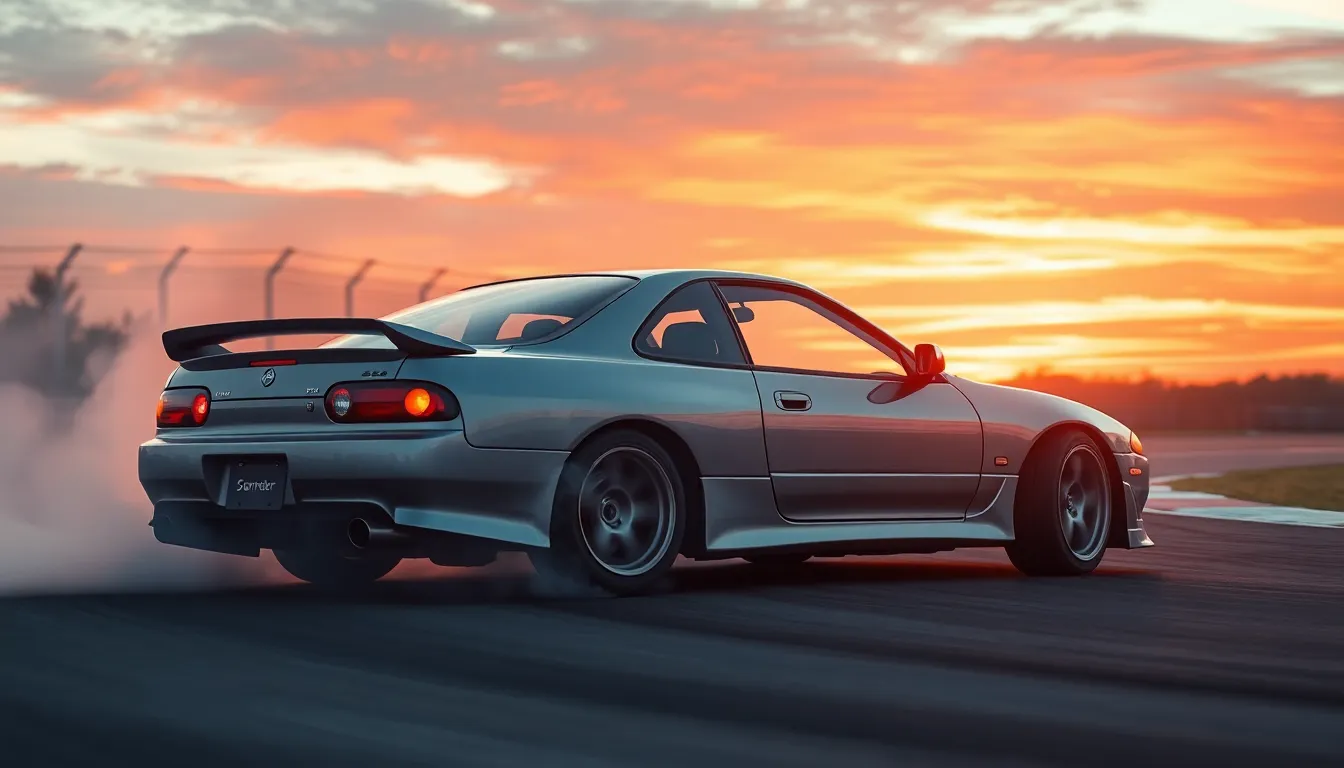
We’ve covered some legendary drift machines, but no discussion about Japanese drift cars is complete without diving deep into the Nissan Silvia series. These models represent the perfect balance of accessibility and performance that made drifting culture truly global.
S13, S14, and S15 Model Differences
S13 Silvia (1988-1993) delivers the purest drift experience with its lightweight 2,535-pound chassis and aggressive styling cues. We find the S13’s sharp-edged design and pop-up headlights create an unmistakable presence on track. Suspension geometry favors quick transitions and responsive handling that beginners can master more easily than heavier platforms.
S14 Silvia (1993-1998) adds refinement while maintaining the drift-focused character through improved aerodynamics and structural rigidity. Engineers increased the wheelbase by 2 inches and added weight to reach 2,685 pounds, creating more stability during high-speed entries. Body lines flow more smoothly than the angular S13, and the fixed headlight design reduces maintenance complexity for daily drivers.
S15 Silvia (1999-2002) represents the final evolution with advanced electronics and the most sophisticated chassis tuning of the series. Weight distribution improves to 54:46 front-to-rear, and the shorter wheelbase compared to S14 enhances agility in tight sections. Modern amenities like traction control and ABS come standard, though most drift builders disable these systems for competition use.
| Model | Weight | Wheelbase | Production Years | Key Advantage |
|---|---|---|---|---|
| S13 | 2,535 lbs | 99.4 inches | 1988-1993 | Lightest chassis |
| S14 | 2,685 lbs | 101.4 inches | 1993-1998 | Best structural rigidity |
| S15 | 2,646 lbs | 100.4 inches | 1999-2002 | Most advanced electronics |
SR20DET Engine Reliability
SR20DET turbocharged four-cylinder powers most Silvia models and delivers exceptional reliability when maintained properly. We see these engines regularly exceed 200,000 miles with basic maintenance schedules that include oil changes every 3,000 miles and timing chain inspections at 100,000-mile intervals. Cast iron block construction withstands boost levels up to 20 PSI on stock internals without major modifications.
Common failure points include turbo oil feed lines that clog after 150,000 miles and valve cover gaskets that leak around 80,000 miles. Cooling system components like the radiator and water pump typically need replacement between 120,000 and 140,000 miles in high-performance applications. Ignition coil packs show signs of weakness around 60,000 miles and cause misfires during aggressive driving sessions.
Modification potential allows SR20DET engines to produce 350+ horsepower with bolt-on upgrades including larger turbochargers, upgraded fuel systems, and engine management tuning. Internal modifications like forged pistons and connecting rods support power levels exceeding 500 horsepower for serious competition builds. Aftermarket support remains strong with companies like Tomei, HKS, and Garrett offering complete upgrade packages.
Global Availability and Import Laws
United States import regulations currently allow S13 and early S14 Silvia models under the 25-year rule that makes vehicles legal for import and registration. We expect S15 models to become available starting in 2024 as they reach the 25-year threshold for federal compliance. Canadian import laws are more lenient, allowing vehicles that are 15 years or older to enter the country with proper documentation.
European markets have access to all Silvia generations through existing right-hand drive regulations that were in place during original production runs. Australian enthusiasts benefit from direct factory imports during the 1990s, making clean examples more readily available than in North American markets. Japanese domestic market examples remain the most desirable due to lower mileage and better maintenance records.
Pricing trends show S13 models ranging from $12,000 to $25,000 depending on condition and modification level in the United States. S14 examples command $15,000 to $30,000, while S15 models in export markets sell for $20,000 to $45,000 based on mileage and originality. Clean, unmodified examples appreciate faster than modified cars as collectors recognize their historical significance in drift culture.
The Classic Toyota Chaser and Mark II
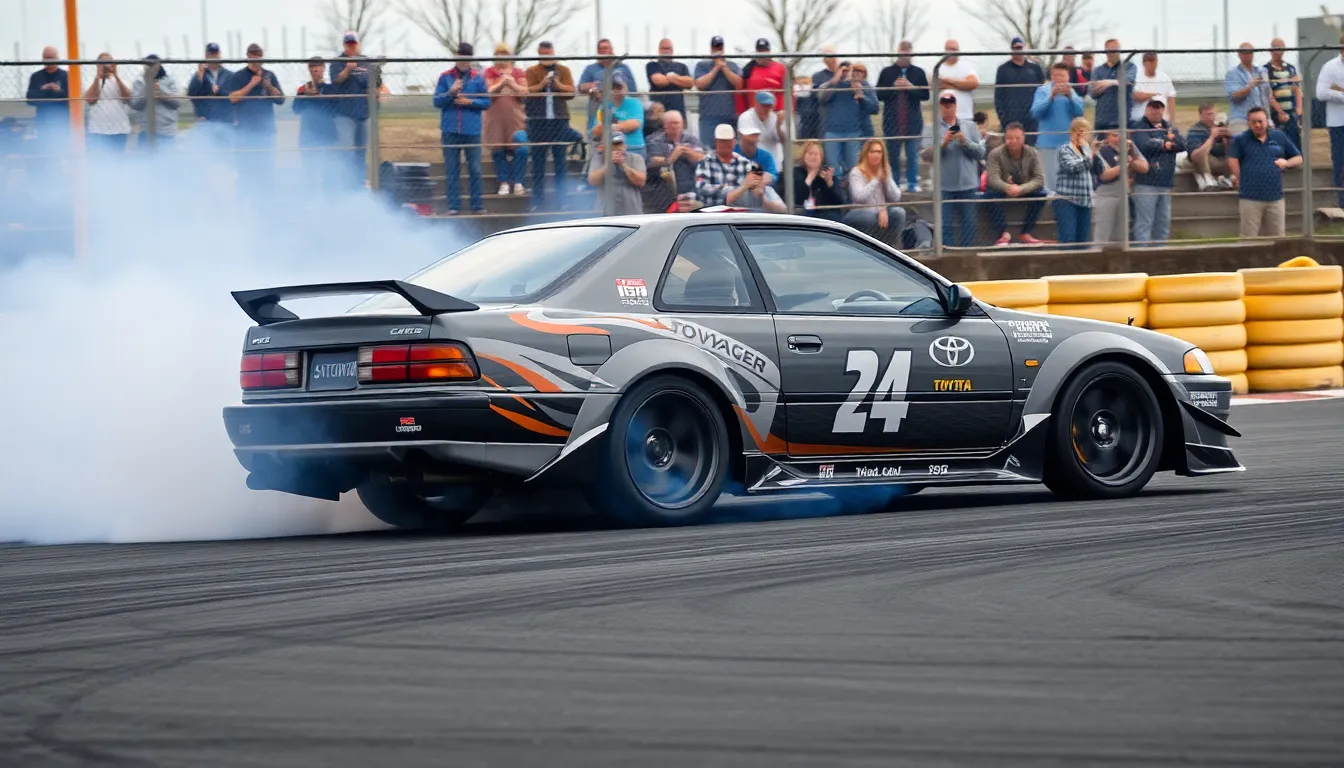
Moving beyond traditional sports cars, we find two exceptional Toyota sedans that changed the perception of four-door drift machines. These luxury performance sedans proved that drift capability doesn’t require two doors or sacrificed practicality.
Four-Door Drift Car Appeal
Spacious interiors make the Chaser and Mark II ideal for crews who need to transport team members and equipment to drift events. Professional drift teams often prefer these sedans because they can carry spare parts, tools, and multiple passengers without compromising performance capabilities.
Weight distribution advantages give these four-door platforms superior balance compared to many traditional sports cars. The longer wheelbase creates more stable drift characteristics, while the additional rear passenger space allows for strategic weight placement during competition builds.
Stealth factor allows drivers to enjoy serious performance without attracting unwanted attention on public roads. These sedans blend seamlessly into traffic while hiding substantial modifications like turbo systems, suspension upgrades, and roll cages beneath their conservative exterior styling.
Affordability compared to sports cars makes these platforms accessible to drift enthusiasts working with limited budgets. Clean examples still cost significantly less than comparable condition Supras or Skylines, even though offering similar engine options and modification potential.
1JZ and 2JZ Engine Options
1JZ-GTE turbocharged inline-six engines deliver 280 horsepower from the factory while offering exceptional modification potential for serious builds. This compact powerplant fits perfectly in the Chaser and Mark II engine bays, providing ideal weight distribution for drift applications.
2JZ-GTE swaps represent the ultimate upgrade path for owners seeking maximum power potential and bulletproof reliability. These legendary engines can handle over 800 horsepower with proper supporting modifications, making them favorites among professional drift teams worldwide.
Single turbo conversions transform the factory twin-turbo 1JZ and 2JZ systems into more responsive powerplants with better low-end torque characteristics. Large single turbos like the Garrett GT3076R or Precision 6266 provide the instant throttle response crucial for precise drift control.
Aftermarket support for both engines includes everything from mild bolt-on upgrades to complete race-built internals. Companies like HKS, Greddy, and AEM offer comprehensive tuning answers specifically designed for these Toyota inline-six platforms.
Professional Drifting Success Stories
Daigo Saito achieved multiple D1 Grand Prix victories behind the wheel of his legendary JZX100 Chaser, proving that four-door sedans could compete with purpose-built drift cars. His success inspired countless enthusiasts to explore the potential of these underrated platforms.
Nobuteru Taniguchi demonstrated the capabilities of the Mark II in Formula D competition, consistently placing among the top drivers while showcasing the sedan’s stability advantages. His technical driving style perfectly matched the predictable handling characteristics of the JZX chassis.
International success followed as drivers like Fredric Aasbo and Ryan Tuerck adopted JZX platforms for exact events and exhibitions. These high-profile endorsements helped establish the Chaser and Mark II as legitimate alternatives to traditional drift cars.
Grassroots victories continue at local and regional drift events worldwide, where budget-conscious drivers consistently outperform more expensive builds. The combination of reliable engines, balanced chassis dynamics, and affordable maintenance keeps these sedans competitive at every level of the sport.
The Budget-Friendly Mazda Miata (NA/NB)
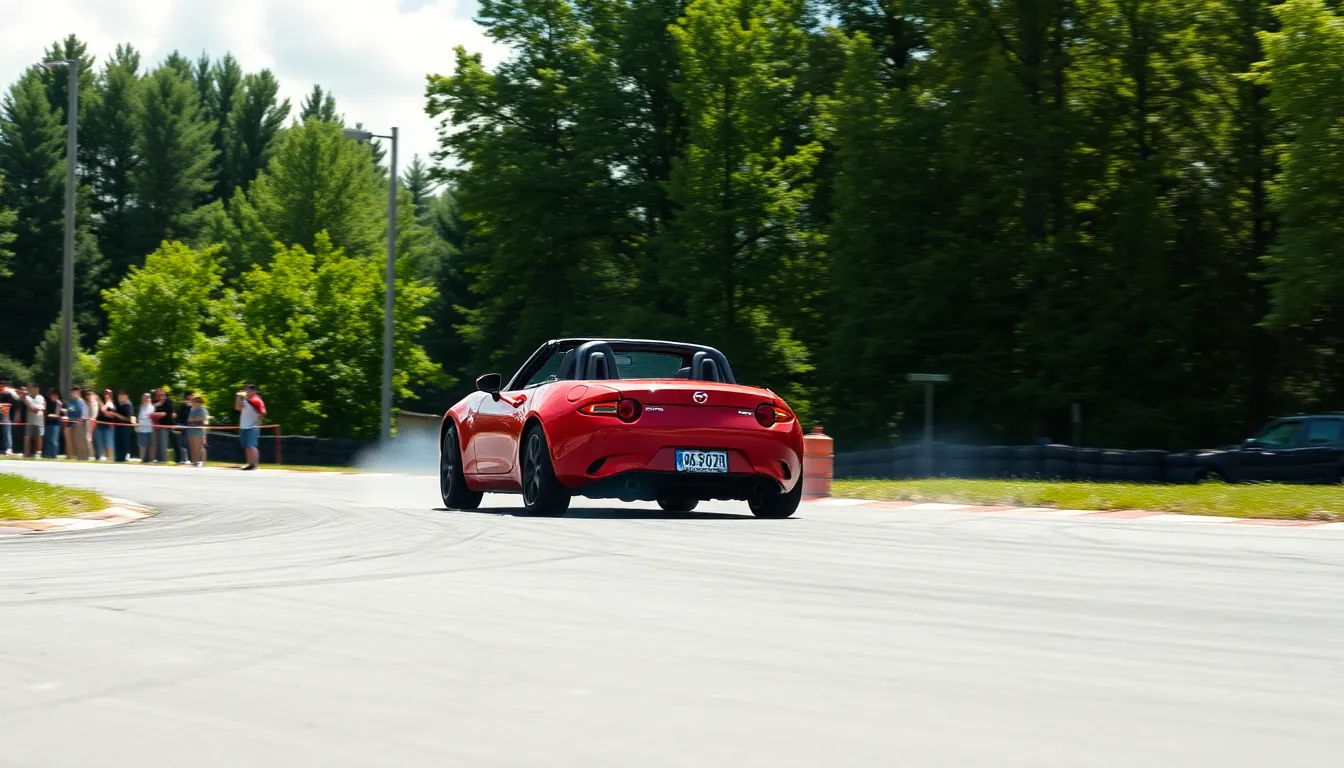
We encounter an unexpected champion in the drift industry when examining the first and second generation Mazda Miata models. These lightweight roadsters offer entry level drifting capabilities at prices that won’t drain your modification budget.
Lightweight Advantage in Competitive Drifting
Weighing just 2,116 pounds, the NA Miata delivers exceptional power to weight ratios that larger drift cars struggle to match. This featherweight construction allows drivers to maintain momentum through technical sections where heavier vehicles lose speed. Professional drivers consistently praise the Miata’s ability to change direction instantly during transition phases.
Balance becomes effortless when your drift car tips the scales at under 2,200 pounds total. The NB generation maintains similar weight characteristics while adding structural rigidity improvements. Tire wear decreases significantly compared to 3,000+ pound drift platforms, reducing operating costs during practice sessions.
Corner speed advantages emerge when physics favors lighter vehicles in technical drift courses. We’ve observed NA and NB Miatas outperforming much more powerful cars in tight, technical layouts. Momentum preservation through linked corners gives skilled drivers competitive advantages over brute force approaches.
Engine Swap Possibilities
SR20DET conversions transform the modest Miata into a serious drift contender with 200+ horsepower potential. This popular swap maintains excellent weight distribution while dramatically increasing power output. Installation complexity remains moderate compared to larger engine transplants, keeping costs reasonable for budget builders.
LS1 and LS3 swaps create formidable drift weapons capable of exceeding 400 horsepower in naturally aspirated form. We’ve documented successful V8 conversions that preserve the Miata’s lightweight characteristics. Weight distribution shifts require careful consideration and often demand chassis modifications for optimal handling.
13B rotary engine swaps honor Mazda’s rotary heritage while providing smooth power delivery ideal for drift applications. These conversions typically produce 200-250 horsepower with excellent throttle response. Rotary engines complement the Miata’s lightweight philosophy better than heavier V8 alternatives.
K24 Honda swaps offer reliable 200+ horsepower with excellent aftermarket support and parts availability. This combination provides daily drivability alongside competitive drift performance. Fabrication requirements remain minimal compared to more exotic engine combinations, appealing to home builders.
Learning Platform for Beginners
Entry costs start around $3,000-5,000 for decent NA examples, making Miatas accessible to newcomers without important financial risk. This low barrier to entry allows beginners to experience drift fundamentals without massive initial investments. Insurance costs remain reasonable due to the vehicle’s modest power output and safety record.
Predictable handling characteristics help new drivers understand weight transfer and throttle control without overwhelming power delivery. The Miata forgives mistakes that would punish beginners in more powerful platforms. Progressive breakaway allows learning proper technique before advancing to higher horsepower vehicles.
Abundant aftermarket support provides endless modification pathways as skills and budgets develop over time. We recommend starting with suspension upgrades before pursuing engine modifications. Parts availability remains excellent for both NA and NB generations, ensuring long term project viability.
Resale values stay strong even after modifications, protecting investment value for budget conscious enthusiasts. Clean examples continue appreciating while modified versions retain their appeal to the drift community. Community support thrives around Miata drift builds, providing technical assistance and parts sourcing help.
The Track-Ready Honda S2000
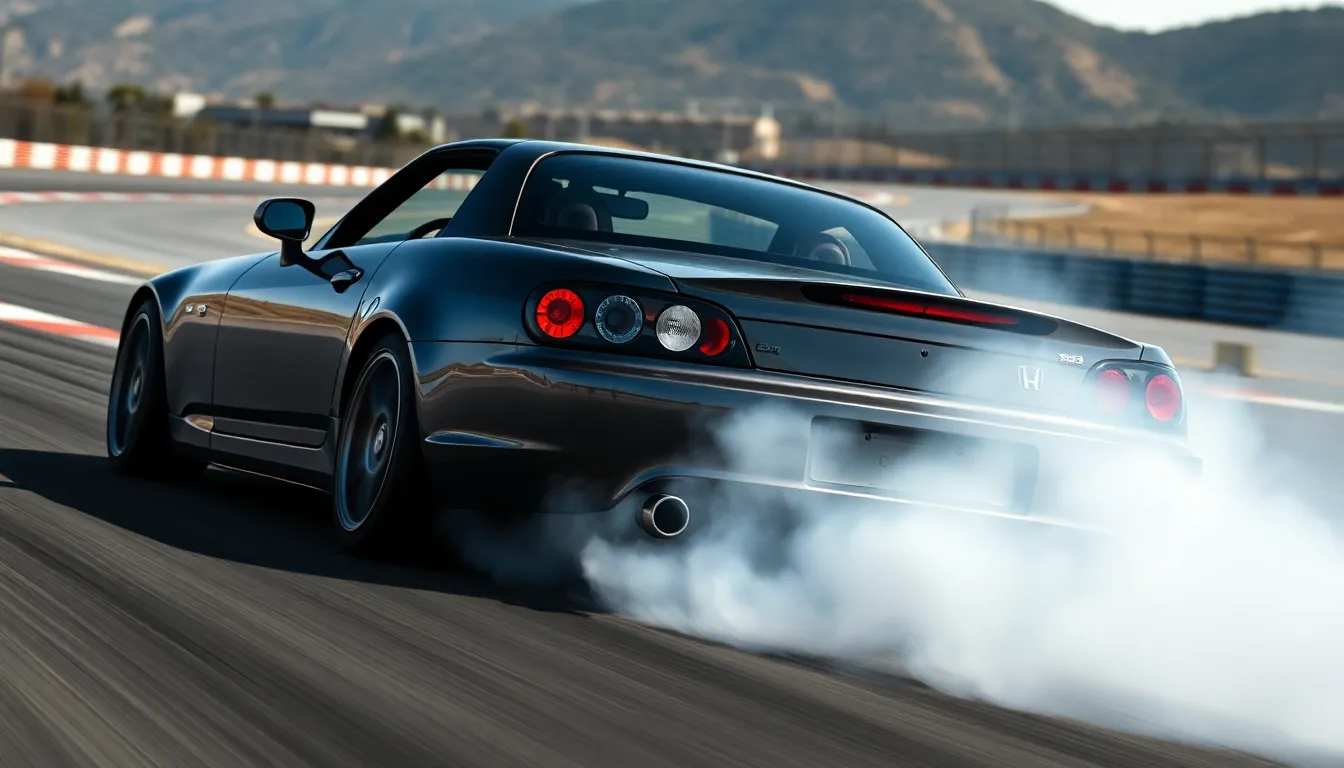
The Honda S2000 brings precision engineering and natural balance to drift competitions with its legendary F20C and F22C powerplants. We’ve witnessed countless S2000s dominate technical courses where finesse matters more than raw horsepower.
VTEC Power Band for Drift Control
VTEC engagement transforms the S2000’s character at precisely 6,000 RPM, creating a distinctive two-stage power delivery perfect for drift transitions. We recommend keeping engine speeds above 5,800 RPM to maintain consistent torque during extended drift sequences.
Throttle response remains instantaneous throughout the rev range, allowing drivers to make micro-adjustments mid-drift without lag or hesitation. Professional drift pilots often tune their S2000s to engage VTEC earlier, typically around 5,200 RPM, for better low-end control during initiation.
Peak power arrives at 8,300 RPM in the F20C engine, providing sustained acceleration through corner exits where competitors often lose momentum. We’ve observed that maintaining higher RPMs helps preserve the S2000’s natural drift characteristics on technical courses.
Factory Balance and Handling
Perfect 50:50 weight distribution gives the S2000 unmatched predictability during drift maneuvers, eliminating the front-heavy characteristics that plague many sports cars. We appreciate how this balance allows for precise steering inputs without overwhelming the rear axle.
Double wishbone suspension at all four corners provides exceptional feedback and control, making the S2000 one of the most communicative drift platforms available. Factory suspension geometry requires minimal adjustment for competitive drifting applications.
Low center of gravity enhances stability during transitions, while the rigid convertible chassis maintains structural integrity under extreme lateral forces. We’ve found that even high-mileage S2000s retain their precise handling characteristics when properly maintained.
Short wheelbase of 94.5 inches creates quick rotation and nimble direction changes, essential for tight technical sections where larger cars struggle. Limited slip differential comes standard, providing optimal traction distribution during power-on drift phases.
Modification Potential and Limits
Engine swaps prove challenging due to the S2000’s compact engine bay and complex chassis design, making naturally aspirated tuning the preferred approach. We typically see power gains of 40-60 horsepower through intake, exhaust, and engine management modifications.
Forced induction requires extensive supporting modifications including fuel system upgrades, intercooling, and strengthened internals to handle boost pressure safely. Turbo or supercharger kits can push output beyond 400 horsepower, though reliability becomes questionable above 350 horsepower.
Coilover suspension systems offer the most important performance improvement, allowing precise ride height and damping adjustments for different track conditions. Adjustable control arms and toe links provide additional alignment options for competitive setups.
Roll cage installation presents unique challenges in convertible models, requiring reinforcement of structural mounting points and careful consideration of weight distribution changes. We recommend professional installation to maintain the S2000’s inherent balance characteristics.
Aftermarket limited slip differentials enhance traction control, though the factory unit performs adequately for most drift applications when properly maintained and adjusted.
Conclusion
Japanese drift cars have fundamentally shaped the motorsport industry we see today. From the legendary AE86 that started it all to the modern engineering marvels like the R34 GT-R each platform brings unique characteristics that define drift culture.
What makes these machines truly special isn’t just their performance potential but their accessibility. Whether you’re starting with a budget-friendly Miata or building a high-end Supra these cars offer pathways for every skill level and budget.
The aftermarket support and modification potential of Japanese drift cars remains unmatched. This network ensures that enthusiasts can continuously evolve their builds while maintaining the authentic spirit of drifting.
Today’s drift scene wouldn’t exist without these iconic Japanese platforms. They’ve proven that with the right combination of engineering balance and passionate community any car can become a legend on the track.
Frequently Asked Questions
What makes the Nissan 240SX the ultimate drift car platform?
The Nissan 240SX features a near-perfect 50:50 weight distribution, rear-wheel-drive layout, and exceptional affordability. Its chassis accepts various engine swaps like the SR20DET, LS variants, and 2JZ-GTE, making it highly customizable. The car’s balanced handling and extensive aftermarket support have established it as the gold standard for drift enthusiasts worldwide.
Why is the Toyota AE86 considered the spiritual foundation of drifting?
The AE86 gained legendary status through 1980s Japanese mountain pass racing, where its 53:47 weight distribution and lightweight chassis proved ideal for tight courses. The “Initial D” anime series further popularized the car globally. Its balanced handling allows skilled drivers to compete against more powerful vehicles, making it a benchmark in professional drifting.
How do Nissan GT-Rs perform in drift competitions despite being all-wheel drive?
Professional drift teams commonly convert GT-Rs from all-wheel drive to rear-wheel drive to optimize them for drifting. The R32, R33, and R34 models feature powerful RB26DETT engines and robust chassis construction. The R34 is particularly favored for its tunability, structural advantages, and performance potential in competitive drifting scenarios.
What advantages do Mazda RX-7s offer for drifting?
The RX-7’s compact 13B rotary engine provides ideal weight distribution and smooth power delivery, enhancing drift control. Both FC and FD generations feature lightweight chassis, low centers of gravity, and rigid construction that contribute to exceptional agility and responsiveness on technical courses, making them highly sought-after drift platforms.
Can the Toyota Supra’s 2JZ engine handle extreme modifications?
Yes, the 2JZ-GTE turbocharged inline-six engine can be modified to exceed 800 horsepower while maintaining reliability. Its robust construction and exceptional aftermarket support make it ideal for high-performance drift builds. The engine’s modification potential, combined with the Supra’s solid chassis, creates an incredibly versatile and powerful drift platform.
What are the differences between Nissan Silvia S13, S14, and S15 models?
The S13 offers lightweight chassis and sharp handling, while the S14 provides improved aerodynamics and stability. The S15 represents the final evolution with advanced electronics and superior chassis tuning. All models feature the reliable SR20DET engine with excellent modification potential, making each generation valuable for different drifting preferences and budgets.
Are four-door cars viable for professional drifting?
Absolutely. The Toyota Chaser and Mark II have redefined four-door drift cars with their spacious interiors, excellent weight distribution, and stealthy appearance. Professional drivers like Daigo Saito and Nobuteru Taniguchi have achieved notable success with these sedans, proving that four-door cars can be highly competitive in professional drifting championships.
Why is the Mazda Miata recommended for beginner drifters?
The Miata’s lightweight construction (2,116 pounds) provides exceptional power-to-weight ratios and predictable handling, making it ideal for learning drift techniques. Its affordability, strong aftermarket support, and various engine swap possibilities (SR20DET, LS1, 13B rotary) allow beginners to enter drifting without significant financial investment while maintaining good resale values.
What makes the Honda S2000 unique in drift competitions?
The S2000 features perfect 50:50 weight distribution, double wishbone suspension, and a low center of gravity that create exceptional handling characteristics. Its F20C and F22C VTEC engines provide precise power delivery ideal for drift control. The car’s natural balance and precision engineering make it highly predictable during drifts, appealing to drivers who value technical precision.
How much should I expect to invest in building a competitive drift car?
Investment varies significantly depending on the platform and competition level. Budget builds using Miatas or 240SXs can start around $10,000-15,000, while professional-level builds with GT-Rs or Supras often exceed $50,000-100,000. Factor in ongoing maintenance, replacement parts, and safety equipment when planning your budget for competitive drifting.

